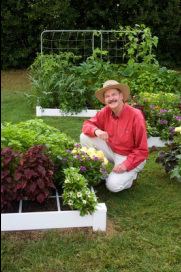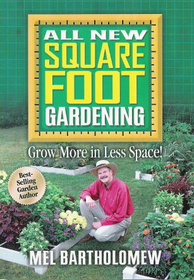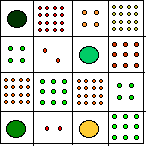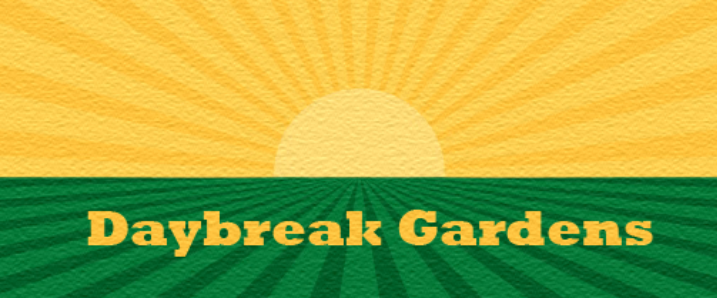Square Foot Gardening

Mel Bartholomew
Square foot gardening is the practice of planning and creating small but intensively planted gardens. The practice combines concepts from other organic gardening methods, including a strong focus on compost, densely planted raised beds and bio intensive attention to a small, clearly defined area. Proponents claim that the method is particularly well-suited for areas with poor soil, beginner gardeners or as adaptive recreation for those with disabilities. The phrase "square foot gardening" was popularized by Mel Bartholomew in a 1981 Rodale Press book and subsequent PBS tv series.
Overview

2006 All New Edition
Conventional gardening can require heavy tools to loosen the soil, whereas in square foot gardening methods the soil is typically not walked on and thus not compacted, and it remains loose and more easily workable. Weeds may be easier to remove due to the light soil, and accessing them can be easier as raised beds bring the soil level closer to the gardener. Conventional gardening can require
Using specific soil mixtures within the beds can help to increase water-holding capacities, so that the garden needs less additional water than in systems reliant on the native soil. Water is also spared by hand-watering directly at the plant roots, so that there is very little waste and tender young plants and seedlings are preserved.
Densely planted crops can form living mulch, and also prevent weeds from establishing or even germinating.
Natural insect repellent methods such as companion planting (i.e. planting marigolds or other naturally pest-repelling plants) become more efficient in a close space, which may reduce the need to use pesticides. The large variety of crops in a small space also prevents plant diseases from spreading easily.
A plywood bottom can be attached to the bottom of a box, which can then be placed on a tabletop or raised platform for those who wish to garden without bending or squatting, or to make gardening easily accessible for wheelchair, cane or walker users.
Since the beds are typically small, making covers or cages to protect plants from pests, cold, or sun is more practical than with larger gardens.
Using specific soil mixtures within the beds can help to increase water-holding capacities, so that the garden needs less additional water than in systems reliant on the native soil. Water is also spared by hand-watering directly at the plant roots, so that there is very little waste and tender young plants and seedlings are preserved.
Densely planted crops can form living mulch, and also prevent weeds from establishing or even germinating.
Natural insect repellent methods such as companion planting (i.e. planting marigolds or other naturally pest-repelling plants) become more efficient in a close space, which may reduce the need to use pesticides. The large variety of crops in a small space also prevents plant diseases from spreading easily.
A plywood bottom can be attached to the bottom of a box, which can then be placed on a tabletop or raised platform for those who wish to garden without bending or squatting, or to make gardening easily accessible for wheelchair, cane or walker users.
Since the beds are typically small, making covers or cages to protect plants from pests, cold, or sun is more practical than with larger gardens.
Mel Bartholomew's Synopsis

The phrase "square foot gardening" was popularized by Mel Bartholomew in a 1981 Rodale Press book and subsequent PBS television series. A full-length companion DVD, "Square Foot Gardening" (2010), was released in collaboration with Patti Moreno, the "garden girl".
The original square-foot-gardening method (per Bartholomew) uses an open-bottomed box to contain a finite amount of soil, which was divided with a grid into sections. To encourage variety of different crops over time, each square would be planted with a different kind of plant, the number of plants per square depending on an individual plant's size. A single tomato plant might take a full square, as might herbs such as oregano, basil or mint, while most strawberry plants could be planted four per square, with up to sixteen radishes per square. Tall or climbing plants such as maize or pole beans might be planted in a northern row (south in the southern hemisphere) so as not to shade other plants, and supported with lattice or netting.
The logic behind using smaller beds is that they are easily adapted, and the gardener can easily reach the entire area, without stepping on and compacting the soil. In the second edition, Bartholomew suggests using a "weed barrier" beneath the box, and filling it completely with "Mel's mix," a combination by volume of one third of decayed Sphagnum peat moss, one-third expanded vermiculite and one-third blended compost. New compost should be added and mixed in each year. For accessibility, raised boxes may have bottoms to sit like tables at a convenient height, with approximately 6" of manufactured soil per square foot. For some plants, such as carrots or asparagus, it is recommended to build areas deeper than 6" in order to facilitate a deeper root requirement.
In Bartholomew's method, the garden space is divided into beds that are easily accessed from every side. A 4' x 4', 16 sq ft garden is recommended for the first garden, and a path wide enough to comfortably work from should be made on each side of the bed, if possible, or if the bed must be accessed by reaching across it, a narrower one should be used so that no discomfort results from tending the garden. Each of the beds is divided into approximately one square foot units and marked out with sticks, twine, or sturdy slats to ensure that the square foot units remain visible as the garden matures.
Different seeds are planted in each square, to ensure a rational amount of each type of crop is grown, and to conserve seeds instead of overplanting, crowding and thinning plants. Common spacing is one plant per square for larger plants (broccoli, basil, etc.), four plants per square for medium large plants like lettuce, nine plants per square for medium-small plants like spinach, and sixteen per square for small plants such as onions and carrots. Plants that normally take up yards of space as runners, such as squash or cucumbers, are grown vertically on sturdy frames that are hung with netting or string to support the developing crops. Ones that grow deep underground, such as potatoes or carrots, are grown in a square foot section that has foot tall sides and a planting surface above the ground, so that a foot or more of framed soil depth is provided above the garden surface rather than below it.
The beds are weeded and watered from the pathways, so the garden soil is never stepped on or compacted. Because a new soil mixture is used to create the garden, and a few handfuls of compost are added with each harvest to maintain soil fertility over time, the state of the site's underlying soil is irrelevant. This gardening method has been employed successfully in every region, including in deserts, on high arid mountain plateaus, in cramped urban locations, and in areas with polluted or high salinity soils. It is equally useful for growing flowers, vegetables, herbs and some fruits in containers, raised beds, on tabletops or at ground level, in only 4 to 6 inches of soil. A few seeds per square foot, the ability to make compost, to water by hand, and to set up the initial garden in a sunny position or where a container, table or platform garden may be moved on wheels to receive light is all that is needed to set up a square foot garden.
External Links for Additional Information About Square Foot Gardening:
Square Foot Gardening Website
Square Foot Foundation - – includes information about square foot gardening and humanitarian projects
Mel Bartholomew's Official Blog
The original square-foot-gardening method (per Bartholomew) uses an open-bottomed box to contain a finite amount of soil, which was divided with a grid into sections. To encourage variety of different crops over time, each square would be planted with a different kind of plant, the number of plants per square depending on an individual plant's size. A single tomato plant might take a full square, as might herbs such as oregano, basil or mint, while most strawberry plants could be planted four per square, with up to sixteen radishes per square. Tall or climbing plants such as maize or pole beans might be planted in a northern row (south in the southern hemisphere) so as not to shade other plants, and supported with lattice or netting.
The logic behind using smaller beds is that they are easily adapted, and the gardener can easily reach the entire area, without stepping on and compacting the soil. In the second edition, Bartholomew suggests using a "weed barrier" beneath the box, and filling it completely with "Mel's mix," a combination by volume of one third of decayed Sphagnum peat moss, one-third expanded vermiculite and one-third blended compost. New compost should be added and mixed in each year. For accessibility, raised boxes may have bottoms to sit like tables at a convenient height, with approximately 6" of manufactured soil per square foot. For some plants, such as carrots or asparagus, it is recommended to build areas deeper than 6" in order to facilitate a deeper root requirement.
In Bartholomew's method, the garden space is divided into beds that are easily accessed from every side. A 4' x 4', 16 sq ft garden is recommended for the first garden, and a path wide enough to comfortably work from should be made on each side of the bed, if possible, or if the bed must be accessed by reaching across it, a narrower one should be used so that no discomfort results from tending the garden. Each of the beds is divided into approximately one square foot units and marked out with sticks, twine, or sturdy slats to ensure that the square foot units remain visible as the garden matures.
Different seeds are planted in each square, to ensure a rational amount of each type of crop is grown, and to conserve seeds instead of overplanting, crowding and thinning plants. Common spacing is one plant per square for larger plants (broccoli, basil, etc.), four plants per square for medium large plants like lettuce, nine plants per square for medium-small plants like spinach, and sixteen per square for small plants such as onions and carrots. Plants that normally take up yards of space as runners, such as squash or cucumbers, are grown vertically on sturdy frames that are hung with netting or string to support the developing crops. Ones that grow deep underground, such as potatoes or carrots, are grown in a square foot section that has foot tall sides and a planting surface above the ground, so that a foot or more of framed soil depth is provided above the garden surface rather than below it.
The beds are weeded and watered from the pathways, so the garden soil is never stepped on or compacted. Because a new soil mixture is used to create the garden, and a few handfuls of compost are added with each harvest to maintain soil fertility over time, the state of the site's underlying soil is irrelevant. This gardening method has been employed successfully in every region, including in deserts, on high arid mountain plateaus, in cramped urban locations, and in areas with polluted or high salinity soils. It is equally useful for growing flowers, vegetables, herbs and some fruits in containers, raised beds, on tabletops or at ground level, in only 4 to 6 inches of soil. A few seeds per square foot, the ability to make compost, to water by hand, and to set up the initial garden in a sunny position or where a container, table or platform garden may be moved on wheels to receive light is all that is needed to set up a square foot garden.
External Links for Additional Information About Square Foot Gardening:
Square Foot Gardening Website
Square Foot Foundation - – includes information about square foot gardening and humanitarian projects
Mel Bartholomew's Official Blog
